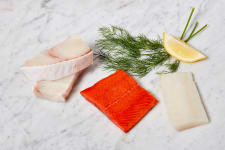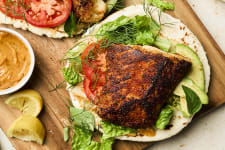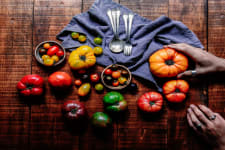Salmon teriyaki has no hard and fast rules. It's simply salmon marinated and cooked in a delicious sauce. You can make salmon teriyaki in many ways, with plenty of room for creativity with ingredients and cooking methods. You can use store-bought sauce and get this sticky, sweet dish on the table in a breeze — or make your own sauce.
What is teriyaki?
Teriyaki is a Japanese cooking technique. Foods are broiled or grilled in a glaze made with traditional Japanese ingredients. That glaze is also commonly called teriyaki sauce. Teri refers to the shine of the sauce, while yaki means grilled or broiled.
Teriyaki Salmon Ingredients
Your primary ingredients are wild-caught salmon (you can't go wrong with sockeye or coho), cooking oil, salt and pepper, and teriyaki sauce. You can use store-bought or homemade.
How to Make Teriyaki Sauce
You can make homemade teriyaki sauce in a few different ways. Authentic teriyaki sauce recipes call for four Japanese pantry staples: salty umami-forward soy sauce, sake (Japanese rice wine), mirin (a sweet rice wine), and sugar (often superfine). All the ingredients are combined in a saucepan in a 1:1:1:.5 ratio and simmered for about 10 minutes until the sauce thickens naturally.
More Westernized versions of teriyaki sauce sometimes include honey, maple syrup, brown sugar, aromatic grated ginger, minced garlic, and chili flakes for a kick. Some versions also include cornstarch to thicken the sauce. Try these glazed teriyaki salmon skewers for a brown sugar variation.
Feel free to adjust the quantities of each ingredient according to your taste preferences, balancing the sauce's saltiness, sweetness, and acidity.
How to Make Teriyaki Salmon
Once you know your sauce plan, you can now marinate and cook. The steps are simple:
-
Coat your salmon in the sauce so it gets infused with the flavor and let it marinate for 15 minutes.
-
Preheat your cooking method.
-
Remove the salmon from the marinade and shake off excess.
-
Cook in the proper pan or on hot, clean grill grates.
Best Ways to Cook Teriyaki Salmon
There are many ways to prepare teriyaki salmon, depending on which cooking method you prefer to use. Each has benefits, ranging from cook time to overall appeal. No matter which cooking method you use, you'll be able to prepare a delicious meal.
-
Grill or pan fry for about 4 to 5 minutes on each side until teriyaki sauce is deliciously browned.
-
Broil for 6 to 8 minutes until the top is slightly charred and the fish is perfectly flaky.
-
Oven bake or air fry teriyaki salmon at 375F for 8 to 10 minutes until the fish cooks through and the exterior caramelizes.
You can make this air fryer teriyaki salmon recipe with broccoli in under 15 minutes. The crispy broccoli florets add texture and make the recipe a complete meal.
The WAC recipe team featured Teriyaki Salmon Air Fried from Frozen in a live event! Watch the recording of the cooking demo to see how it's made.
What to Serve With Teriyaki Salmon
Steamed vegetables like broccoli, snow peas, zucchini, and green beans pair exceptionally well with teriyaki salmon, as does white or brown rice, rice noodles, cauliflower rice, and quinoa. Lightly pickled cucumbers contrast the sauce's sweetness, and miso soup or sauteed napa cabbage are great sides. Keep it light—teriyaki salmon is an umami bomb, so be sure the rest of your plate balances out the bold flavors.
Substitutions
-
Use tamari or coconut aminos in your teriyaki sauce instead of soy sauce to make the recipe gluten-free.
-
Don't stop at salmon! Wild Alaska Pollock and other kinds of fish are delicious with the teriyaki treatment.
-
Use low-sodium soy sauce if you watch your salt intake.
-
You can use powdered garlic and ginger rather than fresh if you opt to make a teriyaki sauce with those aromatics.
Tips
-
Choose high-quality wild salmon over farm-raised for the best-tasting dish.
-
Don't overcook the fish for the best texture. Salmon is ready to eat when it's just no longer translucent and flakes with a fork.
-
Marinate your fish for longer for a more robust teriyaki flavor. You can allow it to marinate for up to an hour.
-
Sprinkle sesame seeds and chopped green onions over the cooked salmon for added texture and flavor.
-
Don't waste the extra teriyaki marinade — boil any remaining sauce on the stove and then baste the cooked salmon.
-
Add a squeeze of lemon to cut the sweetness.







